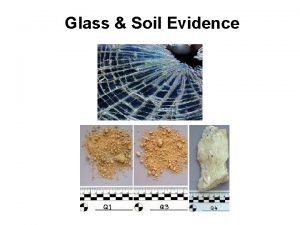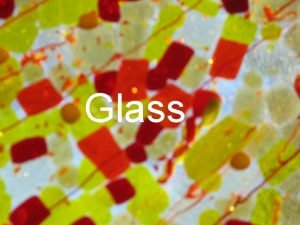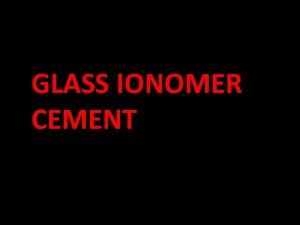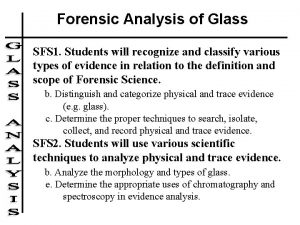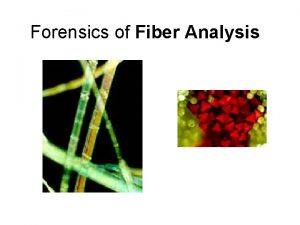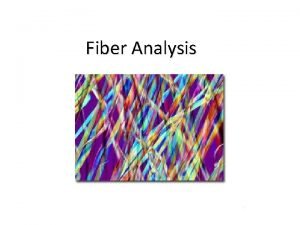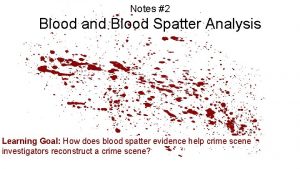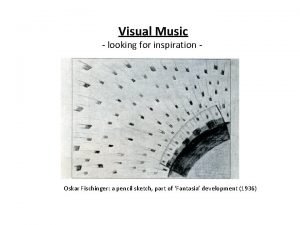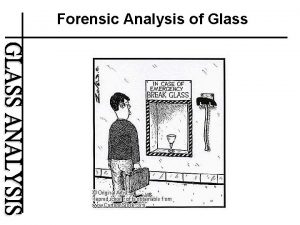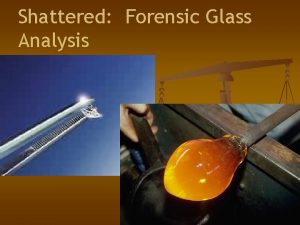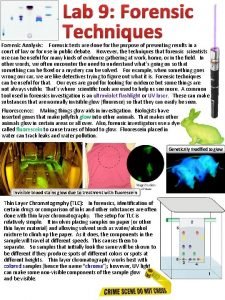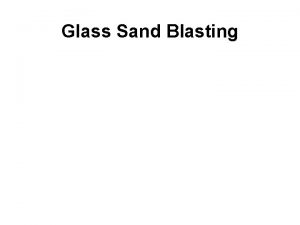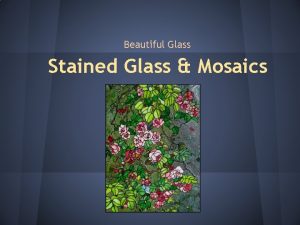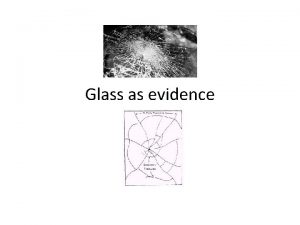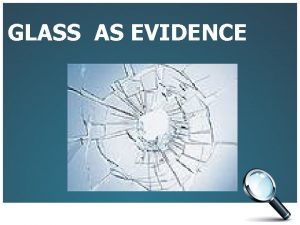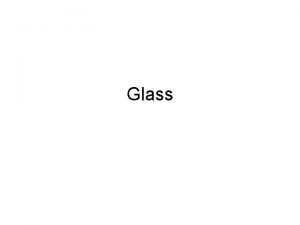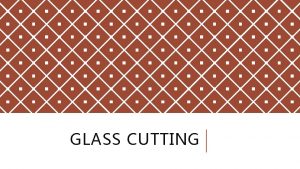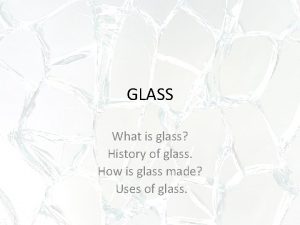FORENSIC GLASS ANALYSIS COMPOSITION OF GLASS Is a

























- Slides: 25

FORENSIC GLASS ANALYSIS

COMPOSITION OF GLASS • Is a hard, brittle, amorphous material • Called an amorphous solid because its atoms are arranged in a random fashion • Due to its irregular atomic structure, it produces a variety of fracture patterns when broken • Has numerous uses and thousands of compositions

COMPOSITION OF GLASS (CONTINUED) • Made by melting the following ingredients at extremely high temperatures • Sand • The primary ingredient • Also known as silica or silicon dioxide (Si. O 2) • Lime or calcium oxide (Ca. O) is added to prevent the glass from becoming soluble in water • Sodium oxide (Na 2 O) is added to reduce the melting point of silica or sand

COMPOSITION OF GLASS (CONTINUED) • Three categories of substances found in all glass • Formers • Makes up the bulk of the glass • Examples: silicon dioxide (Si. O 2) in the form of sand, boron trioxide (B 2 O 3), and phosphorus pentoxide (P 2 O 5) • Fluxes • Change the temperature at which the formers melt during the manufacturing of glass • Examples: sodium carbonate (Na 2 CO 3) and potassium carbonate (K 2 CO 3) • Stabilizers • Strengthen the glass and make it resistant to water • Calcium carbonate (Ca. CO 3) is the most frequently used

COMPOSITION OF GLASS (CONTINUED) • The raw materials for making glass are all oxides • The composition of any sample can be given in terms of the percent of each oxide used to make it. • Borax (Sodium borate) is added to glass and allows glass to withstand rapid changes in temperature.

TYPES OF GLASS • Float glass is a sheet of glass made by floating molten glass on a bed of molten metal, typically tin. • The fluorescent property of float-glass is due to the presence of tin. • Obsidian is a natural form of glass that is created by volcanoes • Soda-lime glass • The most basic, common, inexpensive glass – also the easiest to make • Used for manufacturing windows and bottle glass

TYPES OF GLASS (CONTINUED) • Leaded glass • Contains lead oxide which makes it denser • Sparkles as light passes through it (light waves are bent) • Used for manufacturing fine glassware and art glass • Is commonly called crystal

TYPES OF GLASS (CONTINUED) • Tempered glass • Stronger than ordinary glass • Strengthened by introducing stress through rapid heating and cooling of its surface • When broken, this glass does not shatter, but fragments or breaks into small squares • Used in the side and rear windows of automobiles

TYPES OF GLASS (CONTINUED) • Laminated glass • Constructed by bonding two ordinary sheets of glass together with a plastic film • Also used by automobile manufactures

COMPARING GLASS • Individual Characteristics • Only occurs when the suspect and crime scene fragments are assembled and physically fitted together • Comparisons of this type require piecing together irregular edges of broken glass as well as matching all irregularities and striations on the broken surfaces • Most glass evidence is either too fragmentary or minute to permit a comparison of this type

COMPARING GLASS (CONTINUED) • Class Characteristics (Density and Refractive Index) • The general composition of glass is relatively uniform and offers no individualization • Trace elements in glass may prove to be distinctive and measureable characteristics • The physical properties of density and refractive index are used most successfully for characterizing glass particles, but only as a class characteristic • This data (density and refractivity) gives analysts the opportunity to compare and exclude different sources of data

COMPARING GLASS (CONTINUED) • Density comparison • A method of matching glass fragments • Density (D) is calculated by dividing the mass (M) of a substance by its volume (V) • D=M/V

COMPARING GLASS (CONTINUED) • Refractive Index • A measure of how much an object slows light • Light slows down when it passes through any medium (the denser the medium, the slower the light travels) • Any object that transmits light has its own refractive index • A ratio of the velocity of light in a vacuum to the velocity of light in a particular medium (refractive index = velocity of light in a vacuum / velocity of light in a medium)

COMPARING GLASS (CONTINUED) • When light passes through media with different refractive indexes • Refraction (bending of the light) occurs • This is why objects appear bent or distorted underwater • Every liquid has its own refractive index • If a piece of glass is placed in a liquid with a different refractive index an outline of the glass is clearly visible • This line is known as the Becke Line

METHODS OF COMPARISON: REFRACTIVITY (CONTINUED) • When light passes through a piece of glass placed in a liquid with the same refractive index • The glass bends light at the same angle as the liquid • The Becke Line disappears • The glass seems to disappear

THE BECKE LINE • The Becke Line is a line that appears as a halo if the refractive indexes of the glass and the material are different • The Becke Line will disappear when the refractive indexes are the same

BECKE LINES FROM GLASS Becke line on inside RI of glass (1. 525) > RI of medium (1. 4) Becke line on outside RI of glass (1. 525 < RI of medium (1. 6) The Becke Line is always in the material with the higher refractive index.

GLASS FRACTURE PATTERNS • Glass has a certain degree of elasticity • It breaks when its elastic limit is exceeded • The elasticity produces fractures when it is penetrated by a projectile (i. e. a bullet)

GLASS FRACTURE PATTERNS (CONTINUED) • Types of fractures • Radial • Produced first • Always form on the side of the glass opposite to where the impact originated • Look like spider webs that spread outward from the impact hole • Always terminate into an existing fracture

GLASS FRACTURE PATTERNS (CONTINUED) • Types of fractures (continued) • Concentric • Form next • Encircle the bullet hole • Always start on the same side as that of the destructive force

GLASS FRACTURE PATTERNS (CONTINUED) • Determining the sequence of multiple bullet holes • The radial fractures from the second bullet hole always terminate into the fractures from the first bullet hole • The radial fractures from a third bullet terminate into the radial fractures from the second bullet, and so forth • Determining the first shooter • Examine the termination lines of the radial fractures from each bullet hole • Compare the size of the exit and entrance holes of each bullet

GLASS FRACTURE PATTERNS (CONTINUED) • Determining the direction from which a bullet was fired • Compare the size of the entrance hole to the size of the exit hole • Exit holes • Always larger, regardless of the type of material that was shot • A larger piece of glass is knocked out of the surface where the bullet is leaving because glass is elastic and bows outward when struck

GLASS FRACTURE PATTERNS (CONTINUED) • Determining the direction from which a bullet was fired • Compare the size of the entrance hole to the size of the exit hole (continued) • Entrance holes • The bullet makes a very small hole when it enters • The glass always blows back in the direction of the impact because of its elasticity • The glass snaps back violently after being stressed and can blow shattered glass back several meters • Most of the shattered glass lands on the impacted side of the glass, instead of by the exit hole

COLLECTING GLASS AS EVIDENCE • Avoid the loss or contamination of any evidence samples • Identify and photograph all glass samples before moving them • Collect the largest fragments • Identify the outside and inside surfaces of any glass • Indicate the relative position of multiple window panes in a diagram

COLLECTING GLASS AS EVIDENCE (CONTINUED) • Catalog the samples and keep them separated in order to avoid contamination between two different sources • Separate the glass fragments from any other trace evidence (e. g. , hair, blood, fibers) once in the lab • Examine any clothing (or other objects that may have been used to break the glass) related to the crime scene for glass fragments and other trace evidence
 Glass composition
Glass composition Radial and concentric fractures
Radial and concentric fractures Forensic pathologist vs forensic anthropologist
Forensic pathologist vs forensic anthropologist Forensic psychiatry vs forensic psychology
Forensic psychiatry vs forensic psychology Glass evidence in forensic science
Glass evidence in forensic science What is glass
What is glass Hzfc-d
Hzfc-d Indications of gic
Indications of gic Glass composition
Glass composition Glass analysis forensics
Glass analysis forensics Glass escalator concept
Glass escalator concept If acid is splashed on your skin wash at once with
If acid is splashed on your skin wash at once with Does hot glass look like cold glass
Does hot glass look like cold glass Forensic handwriting analysis video
Forensic handwriting analysis video Why are fibers important to forensics
Why are fibers important to forensics Forensic tire tread evidence worksheet
Forensic tire tread evidence worksheet Fibers from animals
Fibers from animals To show a watermark in a disputed document *
To show a watermark in a disputed document * Forensic analysis of hair
Forensic analysis of hair Owasp cloud top 10
Owasp cloud top 10 Gush blood spatter
Gush blood spatter Kandinsky composition 8 analysis
Kandinsky composition 8 analysis Food composition analysis
Food composition analysis The lady in the looking glass symbolism
The lady in the looking glass symbolism Glass house & philip johnson analysis
Glass house & philip johnson analysis A chip of glass ruby setting
A chip of glass ruby setting




